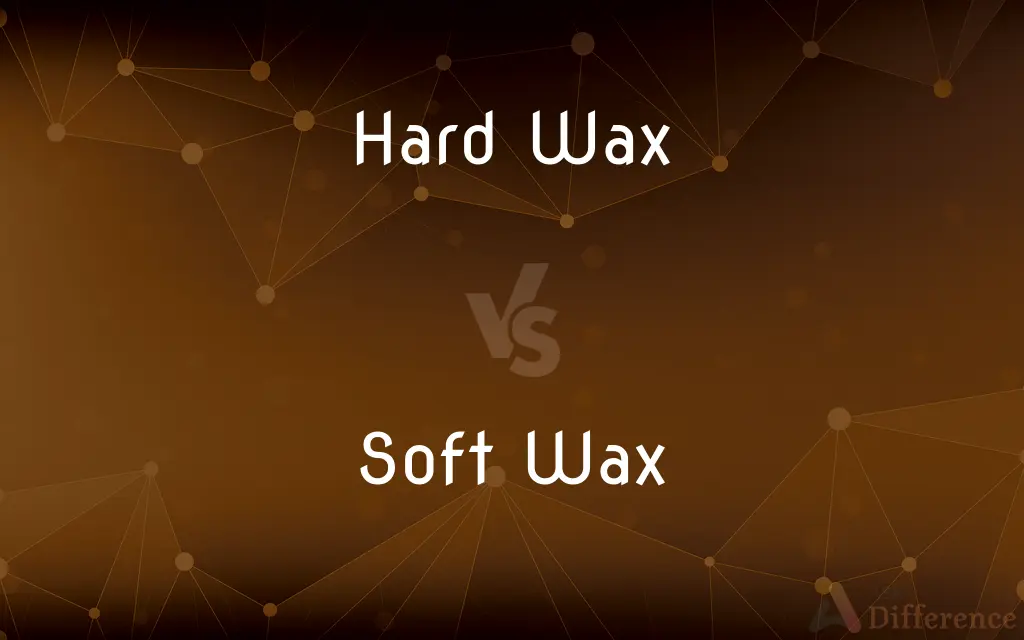Hard Wax vs. Soft Wax — What's the Difference?
By Tayyaba Rehman & Urooj Arif — Published on February 26, 2024
Hard wax is designed to harden on the skin for removal without strips, ideal for sensitive areas, while soft wax adheres to both hair and skin, requiring strips for removal, and is suitable for larger areas.

Difference Between Hard Wax and Soft Wax
Table of Contents
ADVERTISEMENT
Key Differences
Hard wax is applied in a thick layer and allowed to harden, gripping the hair without sticking to the skin, which minimizes discomfort and irritation. This characteristic makes it particularly suitable for sensitive areas.
Soft wax, on the other hand, is applied thinly and requires a cloth or paper strip to be pressed on top for removal. It adheres to both the hair and the skin, which can make the hair removal process more painful but is effective for covering larger areas like legs and arms efficiently.
Hard wax only adheres to the hair, because it can be less irritating to the skin, making it a preferred option for those with sensitive skin. However, its application requires a bit more skill, as the wax must be applied evenly and at the correct temperature.
Soft wax, being more adherent to the skin, can exfoliate the skin surface upon removal, leaving it smoother. However, this also means it can be more painful and potentially cause more redness or irritation, especially in sensitive areas.
The choice between hard and soft wax often comes down to the specific area being treated, the sensitivity of the skin, and personal preference for the waxing process. Some professionals may even use both types in a single session, depending on the needs of different areas.
ADVERTISEMENT
Comparison Chart
Application Method
Applied thickly, removed without strips
Applied thinly, requires strips for removal
Adhesion
Grips only hair
Adheres to both hair and skin
Ideal for
Sensitive areas, small patches
Larger areas, less sensitive skin
Pain Level
Generally less painful
Can be more painful due to skin adherence
Skill Required
Higher skill for effective application
Easier to apply, suitable for beginners
Compare with Definitions
Hard Wax
A type of wax that hardens on the skin for stripless removal, often used for sensitive areas.
She preferred hard wax for to minimize discomfort.
Soft Wax
A wax that remains tacky and requires a strip for removal, suitable for large body areas.
She used soft wax on her legs for a quick and efficient hair removal session.
Hard Wax
Hard Wax is known for its gentle pull, reducing irritation.
The aesthetician used hard wax on her face to avoid redness.
Soft Wax
Suitable for thin, fine hair covering larger areas.
The soft wax was perfect for removing the fine hairs on her arms efficiently.
Hard Wax
Reapplication on the same area is less likely due to efficient hair removal.
The hard wax removed all the hair in one go, eliminating the need for reapplication.
Soft Wax
Soft Wax also exfoliates the skin, leaving it smooth.
After using soft wax, her skin felt not only hair-free but also exfoliated.
Hard Wax
It requires a thicker application and precise temperature control.
Heating the hard wax to just the right consistency was crucial for effective hair removal.
Soft Wax
It's more accessible for beginners due to easier application methods.
For his first DIY waxing attempt, he chose soft wax for its straightforward application.
Hard Wax
Ideal for coarse hair in small, sensitive areas.
Hard wax effectively removed coarse hairs from sensitive parts with minimal pain.
Soft Wax
Can be more painful due to adherence to skin and hair.
She braced for the pull of the soft wax, knowing it would be more painful on her sensitive skin.
Common Curiosities
What is Hard Wax?
Hard Wax is a type of wax that hardens on the skin for easy removal without the need for fabric strips, often used on sensitive areas.
Can Hard Wax be used on any part of the body?
While Hard Wax can be used on most body parts, it's particularly beneficial for sensitive or smaller areas due to its gentle nature.
Why is Hard Wax less painful than Soft Wax?
Hard Wax adheres only to the hair and not the skin, reducing the pain and irritation associated with waxing.
How is Soft Wax used?
Soft Wax is applied thinly over the skin and removed with cloth or paper strips, ideal for larger areas with less sensitive skin.
How often should you wax with Hard Wax?
The frequency of waxing with Hard Wax depends on individual hair growth rates, typically ranging from 3 to 6 weeks.
Is Soft Wax suitable for sensitive skin?
Soft Wax can be used on sensitive skin, but caution is advised as it adheres to the skin and might cause more irritation compared to Hard Wax.
Can Soft Wax be reused in the same session?
Once Soft Wax has been used to remove hair, it cannot be reused due to contamination and loss of adhesiveness.
Does Soft Wax remove hair permanently?
Soft Wax does not remove hair permanently; it pulls hair from the roots, and regrowth typically occurs within a few weeks.
Can Hard Wax cause ingrown hairs?
Like any waxing, Hard Wax can lead to ingrown hairs, especially if proper exfoliation and aftercare are not followed.
Are there any skin preparations needed before using Hard Wax?
The skin should be clean, dry, and lightly powdered if necessary to ensure the Hard Wax adheres properly to the hair.
Is Soft Wax or Hard Wax better for the first-time waxing?
Beginners might find Soft Wax easier to apply, but Hard Wax could be more forgiving on sensitive areas.
Can Soft Wax be used on facial hair?
Soft Wax can be used on facial hair, but caution is advised due to the sensitivity of facial skin.
How can one minimize pain while using Soft Wax?
Keeping the skin taut and quickly removing the strip against the direction of hair growth can help minimize pain with Soft Wax.
Share Your Discovery

Previous Comparison
Residents vs. Intern
Next Comparison
Distilled Water vs. Filtered WaterAuthor Spotlight
Written by
Tayyaba RehmanTayyaba Rehman is a distinguished writer, currently serving as a primary contributor to askdifference.com. As a researcher in semantics and etymology, Tayyaba's passion for the complexity of languages and their distinctions has found a perfect home on the platform. Tayyaba delves into the intricacies of language, distinguishing between commonly confused words and phrases, thereby providing clarity for readers worldwide.
Co-written by
Urooj ArifUrooj is a skilled content writer at Ask Difference, known for her exceptional ability to simplify complex topics into engaging and informative content. With a passion for research and a flair for clear, concise writing, she consistently delivers articles that resonate with our diverse audience.













































